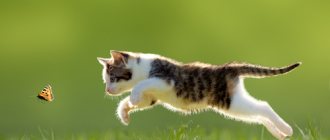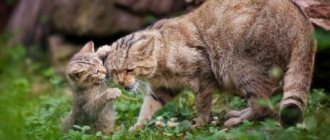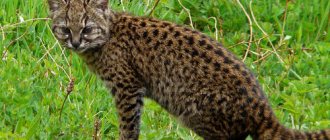Who is the dune cat? This majestic and independent animal is the smallest member of the cat family. In Russia it is almost impossible to meet these animals, although today some exotic lovers are already beginning to appear who import and breed them. Another name for this species is sand or desert cat, which determines its natural habitat. Despite such an insignificant prevalence in our latitudes, the sand cat remains a most interesting representative.
Dune cat: interesting facts
These are not domestic purrs at all, but wild predators accustomed to surviving in harsh natural conditions. They were opened quite a long time ago. Back in 1858, North African representatives of desert cats were discovered. This was not the last discovery. Already in 1926, the sand cat was rediscovered, this time in other parts of the world. In particular, it was the Kara-Kum and Kyzyl-Kum desert. Today, this is one of the few miniature representatives of the cat family that live in the wild. Under natural conditions, they live in Southern Morocco, Tajikistan and Uzbekistan, in Kazakhstan and the central part of the Arabian Peninsula.
Surprisingly, these small and weak-looking animals can go without water for weeks, which means they can survive in the most difficult climatic conditions. The secret is simple: during the day, cats hide in holes to avoid excess fluid loss, and at night they hunt and get the necessary moisture along with food. Such features ensured the possibility of survival in the desert.
Nutrition
The sand cat eats every night. Any living creature that gets in his way can be prey. These can be small rodents, hares, sandstones, jerboas.
Cats are not picky about food, and can be content with insects, birds, lizards, in general, anything that moves. Velvet cats are also famous as excellent snake hunters.
They very cleverly knock down, thereby stunning the snake and quickly killing it with a bite. Being far from water, cats practically do not drink water, but consume it as part of their food and can remain without liquid for a long time.
What does a sand cat look like?
This is a fairly small representative of the cat family. You can even call it small. A distinctive feature is the “shod” soles of the paws. The sand cat lives among hot sand, and a thick layer of thick and hard fur protects its sensitive pads from burns. In addition, such soles create a high supporting surface, which is necessary for animals to move deftly among quicksand and sandy surfaces. The fur of these cats is quite short, but very thick. This coat provides excellent protection from temperature changes: from cold at night, and from intense heat during the day.
Mr. Cat Explains: Description and Natural Range
Felis margarita is perhaps one of the smallest wild cats. The only smaller ones are black-footed African cats, which barely reach a length of 50 cm and weigh no more than one and a half kilograms.
The body of the largest representatives of the Dune cat reaches a length of only 90 cm, of which about half is occupied by the tail. The average individual is only 65 cm.
The height of the animal at the withers is from 20 to 30 cm, the weight of an adult male individual is 2-3 kg. Females are much smaller.
The animal has a massive head; it looks especially wide and flat due to its voluminous cheeks and low-set small pointed ears, which are located almost on the sides of the head.
At the base, the ears are very wide, which helps to better capture sounds and hunt; they are densely covered with long fluff inside and do not have brushes.
Large golden eyes with a vertical pupil, a narrow neat nose on a pointed muzzle, lush earpieces and vibrissae hiding a small mouth complete the appearance of a cute mysterious creature.
Thick and soft sandy-colored fur is long enough to protect against temperature changes in the desert; hard fur grows on the paw pads between the toes, which helps to avoid burns from the hot sand.
The animal’s huge eyes shine unusually brightly in the sun and can reveal the presence of the animal. The sand cat is aware of this feature and always lowers its eyelids when hiding or sitting in ambush and waiting for prey.
Coarse hairs growing between the toes not only protect the paws from the hot soil, but also help to hide, since due to them the cat does not leave marks. In addition, they increase the support area and prevent you from falling into quicksand.
The detailed exterior of the Dune Cat can be described as follows:
- The eyes are large, round, with a yellow iris. In the rays of the sun they become like a crack. The dark pupil is vertical.
- The nose is narrow, elegant with a small flat lobe from soft pink to deep sandy color.
- The ears are wide at the base, of medium height, with pointed tips, set wide and low.
- The head is large and wide with a low, flat forehead and high fluffy “sideburns” on the cheekbones.
- The body is small and strong, from 40 to 52 cm.
- The limbs are short and strong, with a powerful fur trim.
- The claws are short and sharp, but often worn down due to climbing rocks.
- The tail is long and fluffy, making up at least 40% of the body size, 23-29 cm.
- Wool of medium length, printed.
- Color depends on the habitat. The color of the coat varies from golden, light sandy to grayish. This variability in color is explained by the color of the soil, because the animal should not stand out against its background, but simply blend in with it. The tip of the tail is usually dark, the chest, abdominal area and the inside of the legs are lighter. In winter, the hair becomes darker and loses its brightness.
Exterior
Body length is only 70-90 cm. This is together with the tail, which makes up at least 40%. That is, the cat’s body itself is only about 40 cm. The height at the withers barely reaches 24 centimeters, and the weight is 3.5 kilograms. If you consider that there are domestic cats weighing 15-20 kg, then these are absolutely crumbs. The sand cat, or sand cat, is perfectly adapted to survive in natural conditions. Its color allows it to completely blend with the surface of the dunes. Colors range from golden to light brown. There are also light gray individuals, but this is rather an exception.
Appearance
The sand cat is the smallest representative of wild cats. Its body grows in length only up to 65–90 cm (of which 40% is occupied by the tail). At the withers it reaches a size of only 24–30 cm. Males weigh from 2 to 3.5 kg, females differ from males in smaller sizes.
The head of this type of cat is large and wide, slightly flattened. There are sideburns on the cheeks. The ears are large and wide. The eyes are yellow. The legs are short and strong. Since in its natural environment the dune cat lives in places with sand hot from the sun, nature took care of protecting its paws. This cat's feet have hard fur that protects them from burns.
Sandy cats have short, but thick fur that protects them from temperature changes during the day and night. The color ranges from sandy to light gray, which allows the sand cat to successfully camouflage itself. The back and tail are covered with darker stripes, which can blend in with the overall color. On the head and paws these stripes are brighter. The tail is black at the end. The chest and bottom of the muzzle are lighter than the general tone. Dune cats living in Central Asia change their fur in winter to a thicker, pale sandy color with a grayish tint.
The color of the cat also differs from its subspecies:
- Fm margarita can be found in the Sahara. This species is the smallest of the sand cats. It has the brightest color, and on its tail you can count from 2 to 6 dark stripes.
- Fm thinobia, or Transcaspian dune cat. The largest among other species. But its color is dull, the pattern is barely noticeable. There are up to 3 rings on the tail.
- Fm scheffeli from Pakistan is similar in color to the Trans-Caspian dune cat, but differs from it in a brighter pattern and more stripes on the tail.
- Fm harrisoni, which lives on the Arabian Peninsula, is distinguished from others by a dark spot on the back of the ear. Adult cats also have 5 to 7 rings on their tail.
Photo gallery: appearance of a dune cat
Natural habitat
The sand cat is a true extreme animal with an amazing ability to survive. These animals live even in the driest areas, surviving among the dunes, where the landscape is brightened only by dry bushes. Having adapted to such difficult conditions, cats lead a nomadic lifestyle. They constantly move through the desert in search of food. It is very difficult to detect this cat; it moves so easily that it leaves no traces. The activity of these animals is observed mainly at night, since during the day it is too hot, and the prey hides in holes. Often attempts to find representatives of this species ended in failure. The cat hides very well, moves, clinging to the ground, and when it notices the trace of a flashlight, it presses itself even closer to the sand and closes its eyes so that the light does not reflect in them.
Character and behavior of the Dune cat
It is difficult to find food in sufficient quantities in the desert, so Dune cats constantly migrate.
As shelters in conditions of constant movement across desert terrain, Sand cats rarely dig holes on their own; more often they use abandoned dens of other animals, mainly foxes and porcupines.
They dig small holes very quickly thanks to their short and strong legs. Most often, animals sit in them during the day, and at dusk they go out hunting.
When leaving the shelter, the Dune Cat freezes for several minutes and carefully studies the surrounding space in order to notice the enemy in time. With exactly the same precautions, the small predator returns to its lair.
The uniqueness of Sand cats is that these animals can live in the absence of water. Their body is able to accumulate liquid, extracting it from any food.
To ensure that precious moisture is wasted to a minimum, animals do not go out into the scorching rays during the day, but shift their hours of greatest activity to the evening, night and early morning.
The sand cat is very small, but swift. During the night he is able to cover an area of about ten square kilometers. The animal runs, practically lying flat on the sand and lowering its head low, which creates a highly streamlined body. At the same time, the animal is capable of reaching speeds of up to 40 km/h. This method of movement, coupled with a high speed of movement, allows the cat to remain almost invisible and blend in with the sand. Even in sunlight, few predators are able to notice a moving Dune Cat.
In addition, it is an unusually intelligent animal. If a person shines a spotlight on it while hunting, the animal closes its eyes so as not to give itself away by the reflection of the iris.
Having adapted to a hot and dry climate, Sand cats really do not like precipitation, which is extremely rare in the desert, but possible in the adjacent territories. In order to wait out the rains, cats dig deep holes, up to 1.5-2 meters deep.
Despite the fact that Dune cats prefer to lead a solitary lifestyle, they are rather friendly towards their fellow cats, do not enter into confrontation and are even able to shelter them in their burrow. Due to the minimal amount of living life in the desert, Dune cats are excellent hunters.
The predator compensates for its miniscule size with the thoughtfulness of its attack and the swiftness of its throw. The habit of stockpiling and unpretentiousness helps these animals survive in conditions of total food shortage.
The sand cat will not refuse even a snake. The Arab variety is especially famous and interesting for these deadly fights. The predator acts in a unique way and often defeats even a viper - it unexpectedly hits its opponent on the head, stunning the prey, and then finishes it off by biting its neck.
In winter, when the minimum life in the desert that is active in the summer freezes, Dune cats move closer to human settlements. Although it is people who are the main enemies of these animals. Jackals, monitor lizards, bird predators, and caracals are also dangerous for sand cats. Despite the fact that hunting the Sand Cat is very difficult, man does not give up his claims to this prey. Most often, animals are caught for subsequent sale.
The greatest harm to the population is caused by humans ineffective management of pasture resources and eradication of the natural biotope.
Diet
Like all other members of the family, these cats are predators. Under natural conditions, they eat everything they can catch. These can be jerboas or hares, snakes and large insects. These little ones manage to catch quite large prey, and the cat will never throw away the remains of the meal, but will bury it to return the next day. A sand cat at home retains its instincts, so you are guaranteed eggs under the pillow and bones behind the cushion of the sofa.
To save precious moisture and protect themselves from the heat, cats dig minks for themselves, but this is only a last resort. Most often they use the old shelters of foxes and other desert inhabitants.
Hunting and natural enemies
These cats are skilled hunters, otherwise they will not survive in the harsh desert conditions. They hunt from ambush. The cat jumps out at the victim, grabs it by the neck and shakes it vigorously. Then, with the help of teeth and claws, he tears off pieces of meat and satiates himself. If the prey is large, then the cat may not leave the place of daytime shelter for several more days, going out to hunt again only when the supplies come to an end. Usually the hunting grounds are very large, the territory sometimes exceeding 15 square kilometers. In winter, animals approach human settlements, but never come into contact with domestic cats.
Furry beauties also have natural enemies. These are snakes, large birds of prey and jackals. What saves them from destruction is their natural dexterity and caution, the ability to camouflage and hide well.
Reproduction of the dune cat
In the wild, these animals reproduce at the end of January. The offspring are born in April. Usually the litter is not too large; the female brings 4-5 kittens at a time. They grow up very quickly, natural conditions spur natural processes. Already at 3 weeks they make their first attempts to get out of the hole and explore the big world. At about 4 weeks they transition from their mother's milk to solid food. Very little time will pass, and they will leave for an adult, dangerous life. Four-month-old babies hunt completely independently, and at 6-8 months they most often separate from the parent. This is surprising, because at this age, domestic kittens are still often fed milk by their mother.
The sand cat breeds more than once a year at home. In nature, their reproduction is seasonal, it is timed to changing environmental conditions, periods of rain and drought. In captivity, biorhythms are disrupted. It must be said that today only 9 individuals of this species live in different zoos around the world. There is information about attempts to take kittens from the wild and raise them at home as pets. It is quite possible. A sand cat raised in captivity will not be afraid of humans, but will retain all its wild instincts and may one day go free, where it will die due to lack of survival and hunting skills.
Today, the habitat of these animals is increasingly narrowing. The reason is human economic activity. As we advance, proud and independent creatures go deeper into uninhabited territories.
Population today
Scientists say that it is difficult to even roughly calculate the number of living individuals, this cat leads such a secretive lifestyle. However, after conducting various observations, experts came to the conclusion that in 1996 there were 50,000 sand cat individuals living in the world. This is a very small number. Such studies prompted the inclusion of cats on the list of protected animals. Unauthorized capture of animals for the purpose of domestication or breeding is prohibited; only nature reserves and zoos have such powers. The sand cat, a photo of which you can see in the article, must continue to live in its natural habitat in order to maintain the harmony of the ecosystem.
General information
City residents perceived local cats as an integral feature of the city, just as we now perceive pigeons. They preferred to buy kittens of exotic European breeds for home decoration, but catching mice in barns was just the thing for the semi-wild Mau.
Until 2004, the region's native cats were not of interest to the breeding community. It was only thanks to the efforts of Petra Müller that cats were selected to compile a stud book and breed the breed as a full-fledged show cat, and not as a semi-wild animal from the local streets.
The breeder benefited from the health of the selected cats, their strong bodies, which had gone through a long path of natural selection, helped create a breed line in just 4 years. By 2008, the breed was officially recognized by the WCF.
INTERESTING: it is the ancestors of the Arabian Mau that are considered the cats of the Prophet. To this day, all cats are treated with reverence in Islam; they are even allowed free access to mosque buildings.
Dune cat at home
Today it is fashionable to keep unusual breeds of cats and dogs and exotic animals at home. But before you decide on such an acquisition, it’s a good idea to think about the fact that this is a wild animal that has centuries of life behind it in natural conditions, and not near a saucer of milk. For a domestic cat, life on the sofa is familiar and correct, but for desert dwellers it is extremely stressful. Of course, a lot depends on the age at which you purchased the kitten. However, there are sad cases where people have purchased fishing cats or sand cats. While the kittens were small, everything went well, but as soon as the older animal began to show character and show its claws, they got rid of it.
If you dream of such a cat, then you should know that their life expectancy in captivity is 12-14 years, but only if properly cared for. If you do not have such skills, moreover, have not acquired the necessary knowledge, most likely the animal will die.
Captivity
Information on the size of the world population of the Dune Cat varies greatly. The collection of accurate data has only recently begun thanks to the development of video surveillance.
Already in this century, the Dune Cat was taken under the protection of zoological centers. They voice the population figure of 50 thousand individuals, but hardly anyone can vouch for its accuracy due to the high secrecy of the animals.
Now the Sand Cat is listed in the International Red Book as the most vulnerable and close to extinction species.
This animal is kept in some large zoos in the world, which greatly value such rare pets. The number of adults living in captivity is believed to be only nine. Occasionally, animals travel to other zoos to breed and produce offspring.
These rare endangered animals living in zoos are known to the world by name. For example, the Kalahari cat, the marriage partner of the Israeli cat Rotem, came to visit a friend from Sweden. The result of this visit was the birth of three Sand kittens. This is very rare, since in captivity these animals have very poor contact with each other and cases of the birth of cubs are rare. In addition, captivity is stressful for mothers and they often abandon their offspring, which leads to the death of their babies.
Optimal living conditions
It is best if you live in a private house, since in this case the cat will have the opportunity to hunt. For the health of your wild pet, it is necessary to ensure low humidity and stable temperature in the room where the cat lives. You should not buy this animal if you have a small apartment. A free animal needs a fairly large space in which it can move freely.
Living at home can lead to serious stress and, therefore, a decrease in immunity. Absolutely healthy in the wild, at home such cats often begin to suffer from various viral infections. Vaccination is vital for them, do not neglect this rule. The diet must include several types of meat, usually chicken and beef.
Let's sum it up
The sand cat is a charming and amazing creature, a real flower of the desert. But the proud and independent animal does not tolerate life well in the modern civilized world, so it is better to leave them in their natural habitat and give them the opportunity to continue their race. Only small kittens adapt well to home conditions; taming an adult will be much more difficult. There are a huge number of stray cats in the city that are drawn to people and are ready to purr on their laps for days on end. And wild animals need to be given the opportunity to live in the wild.











